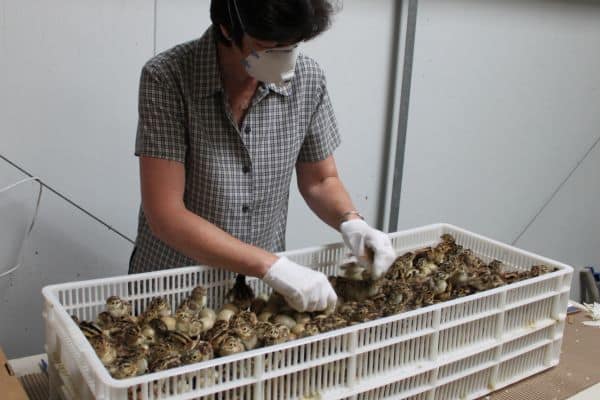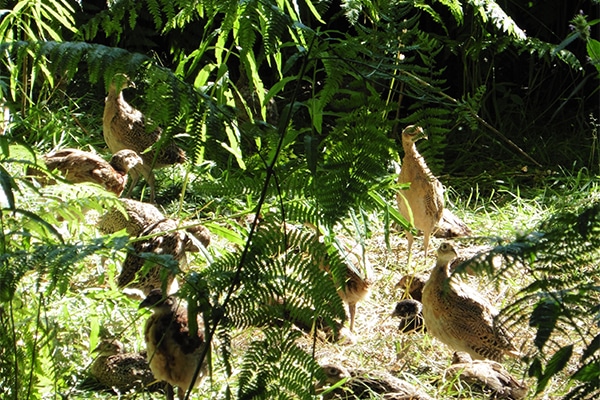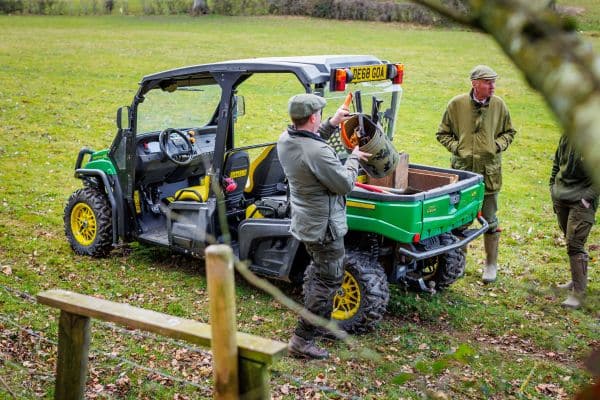
Poultry registration form guidance
In the UK, it is a legal requirement to register kept birds, including gamebirds when they are kept.
Get information on the legal shooting season for mammals and birds in the UK.
Apply for funding for your project or make a donation today
Comprehensive information and advice from our specialist firearms team.
Everything you need to know about shotgun, rifle and airgun ammunition.
Find our up-to-date information, advice and links to government resources.
Everything you need to know on firearms law and licensing.
All the latest news and advice on general licences and how they affect you.


Home » Gamekeeping » Land management » Game cover crops
To create an environment in which gamebirds and other wild birds can flourish, areas of game cover crop are often planted to provide additional habitat.
In the UK, game shoots maintain 25,000ha of this dedicated habitat1 which is purposely left unharvested to provide a source of food and shelter for an array of wildlife.
Areas of cover crop are primarily planted to support game shooting, but their existence significantly increases the abundance of farmland birds(2), many of which are red-listed species.
There are, however, dedicated wild bird and wildflower crops, the sole purpose of which is to increase biodiversity. Fundamentally, gamebirds and farmland birds require habitats which offer three key elements: food availability, shelter and nesting cover.
If you can create a mosaic of different habitats which meet these demands, species diversity will increase; often this is achieved by using a variety of crop types across different sites in conjunction with woodland and hedgerows.
Select crops which produce a naturally occurring food source, and more importantly, ones that provide seeds and grains into the late winter months. Given that game cover crops generally require little insecticide treatment, they can harbour a diverse abundance of invertebrates in the spring, creating a fantastic brood-rearing area for wild birds.
The additional food available from seed and grain bearing crops will also help to hold gamebirds on a shoot, keeping them busy throughout the day.
A game cover crop should provide its inhabitants with protection from the weather and from predation. Select crops which can stand strong throughout the winter months and offer shelter at a time when natural cover is low. It is important to follow recommended drilling rates and row widths of individual crop species; a crop which is too thick can become impenetrable and prevent birds from using the whole crop, preferring the perimeter instead.
Crops need to have sufficient sunlight breaking through the canopy to allow birds to dry themselves after periods of prolonged wet weather. Brassicas such as kale are hardy crops which can withstand severe weather but they typically need wide rows (approx. 50cm) to prevent them becoming too thick. Repeated use of brassicas can result in clubroot problems.
While gamebirds like partridges prefer to nest within tussocky field margins or hedgerows, after hatching the hen will often take her brood to game cover crops for shelter and the abundance of insects that serve as chick food.
Large fields can be dissected by beetle banks3 which create additional overwinter habitat for insects. Maintaining a high population of insects will provide greater availability of food in the spring.
Beetle banks also offer nesting cover and provide wildlife corridors for birds to move between hedgerows and cover crops under relative safety from aerial predation.
Planting perennial crops can ensure that good nesting cover for farmland birds is available in the spring; crops such as canary grass can be used as a windbreak to surround species prone to wind damage, but also provide excellent nesting habitat for small birds.
It is important to check your obligations, if there are any, to agri-environment schemes, as this may impact what planting options you have; you must also ensure that any relevant permission or consent is secured.
Well before any seedbed preparation takes place, it is important to know the condition of the soil in each earmarked location. Investing time in soil sampling can help rule out potential issues such as nutrient deficiencies, soil compaction or unsuitable levels of acidity/alkalinity (pH). This will pay dividends in the long run and result in better crop growth; it is worth seeking professional advice from specialist seed suppliers.
Close working relationships with farmers or contractors is imperative for successful crop establishment – often they will be responsible for the preparation and drilling of sites. Some crops can be dual purpose. Stubble turnips, for example, can be used as an alternative to conventional game crops where winter-hardy cover is needed, but also serve as a forage crop; after the shooting season is finished, a field of stubble turnips can be handed over to the farm and strip-grazed by livestock.
The array of crop species can be daunting and confusing. ‘Straights’ such as maize have proven reliability in holding game, especially partridges, but there are drawbacks.
Maize can attract large numbers of rats, badgers and deer which feed on the cobs, damaging the maize crop itself, and increasing the likelihood of significant damage to adjacent areas. It also lacks tangible benefits for farmland birds and other wildlife species, which is why maize is not covered by agri-environment schemes. If maize is used, it is best integrated with a wild bird cover to provide biodiversity benefits.
In contrast, mixed crops provide the greatest diversity of sub habitat structures, as each species will establish and ripen at different times. These types of crop often contain brassicas (such as kale) which provide excellent cover and seed food value. Cover mixes which contain triticale, quinoa, millet and linseed produce a high volume of nutritious seed which benefits a wide range of farmland birds throughout winter and spring – often referred to as the ‘hungry gap’.
For maximum conservation benefit, a mosaic of different crops should be planted across the shoot on a rotational cycle. By carefully selecting a variety of annual and perennial mixtures, a shoot can ensure that foraging habitat, shelter and nesting cover are maintained throughout the year.
Late-sown mixtures can be drilled until August/September, which allows for delayed seedbed preparation. This enables over-wintered stubbles and/or previous crops to be left as nesting cover for farmland birds.
Weeds will inevitably grow as pioneer species on these areas, but they provide insect habitat, which in turn supports insect life for wild broods. Weeds like fat-hen and redshank can also provide a natural food source.
Implementing an effective weed control programme will create a stale-seedbed prior to summer planting. Late-sown crops can be used as recovery crops to thicken or replace a spring crop which has failed.
Perennial crops can provide regenerating cover for over five years when managed correctly; they are an excellent option if machinery access is difficult and/or soil type is poor. However, perennials rarely provide sufficient cover in their first year, so a one-year nursery crop can be sown in addition to ensure sufficient habitat is provided.
A fantastic but widely underappreciated perennial is chicory. From year two, chicory will grow to two metres tall with a thick base which offers brilliant brood rearing habitat and cover for released gamebirds.
It is important to closely monitor emerging crops. Pests like flea beetle and slugs can cause serious damage to brassica crops, and kale variants are highly susceptible to attack from woodpigeons, so a fast-growing nursey crop like mustard will provide some protection until the kale plants establish fully.
If serious crop damage occurs due to pest bird species, ensure the relevant general licence is adhered to. Once crops are established, it may be necessary to carry out some habitat management such as ride cutting. This creates sunny areas within the crop where birds can feed and dry themselves after periods of wet weather.
2 Parish D.M.B. & Sotherton N.W. (2004) Game crops as summer habitat for farmland songbirds in Scotland. Agriculture, Ecosystems & Environment, 104, 429-438
3 gwct.org.uk/farming/advice/sustainable-farming/beetle-banks/
4 David M.B. Parish & Nicolas W. Sotherton (2004) Game crops and threatened farmland songbirds in Scotland: a step towards halting population declines? Bird Study, 51:2, 107-112

In the UK, it is a legal requirement to register kept birds, including gamebirds when they are kept.

How to create a pheasant pen that meets The Code of Good Shooting Practice’s requirements.

All the guidance and advice you need on all aspects of game, habitat and shoot management.
Sign up to our weekly newsletter and get all the latest updates straight to your inbox.
© 2025 British Association for Shooting and Conservation. Registered Office: Marford Mill, Rossett, Wrexham, LL12 0HL – Registered Society No: 28488R. BASC is a trading name of the British Association for Shooting and Conservation Limited which is authorised and regulated by the Financial Conduct Authority (FCA) under firm reference number 311937.
BASC Direct Ltd is an Introducer Appointed Representative of Agria Pet Insurance Ltd who administer the insurance and is authorised and regulated by the Financial Conduct Authority, Financial Services Register Number 496160. Agria Pet Insurance is registered and incorporated in England and Wales with registered number 04258783. Registered office: First Floor, Blue Leanie, Walton Street, Aylesbury, Buckinghamshire, HP21 7QW. Agria insurance policies are underwritten by Agria Försäkring.
If you have any questions or complaints about your BASC membership insurance cover, please email us. More information about resolving complaints can be found on the FCA website or on the EU ODR platform.